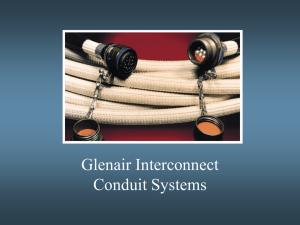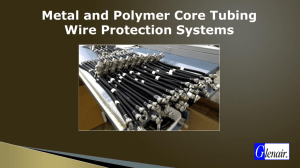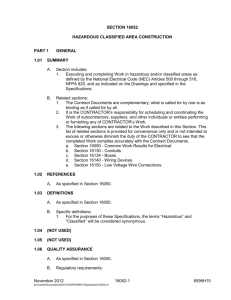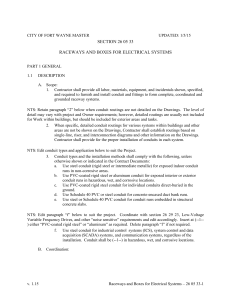Nondestructive Evaluation Methodologies
advertisement
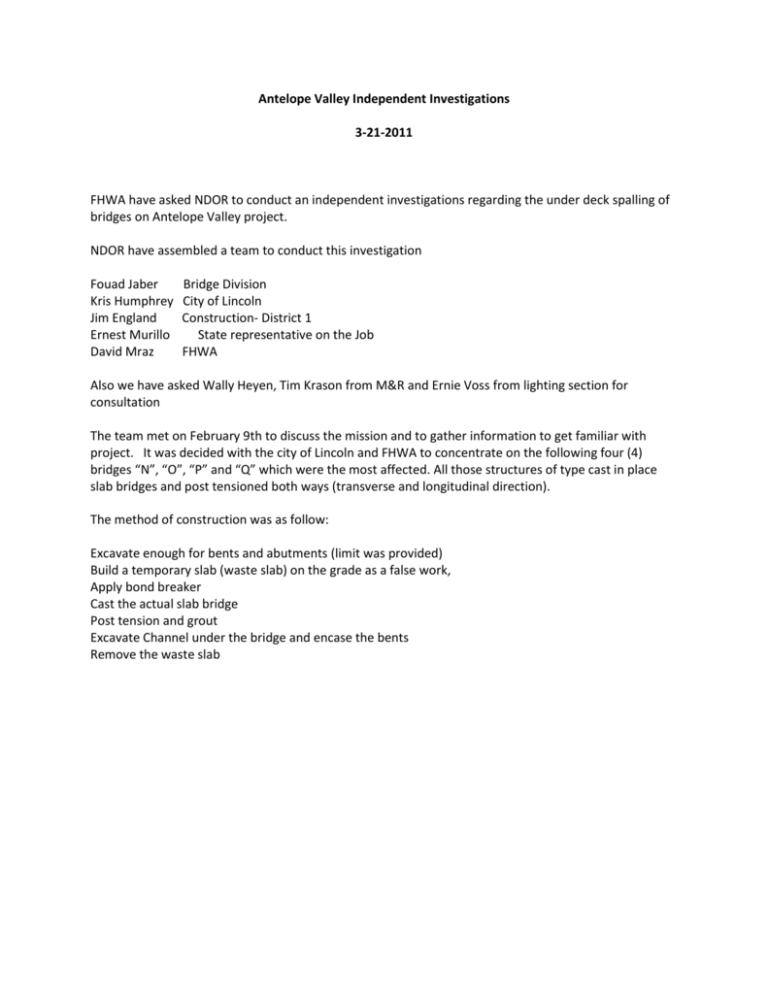
Antelope Valley Independent Investigations 3-21-2011 FHWA have asked NDOR to conduct an independent investigations regarding the under deck spalling of bridges on Antelope Valley project. NDOR have assembled a team to conduct this investigation Fouad Jaber Kris Humphrey Jim England Ernest Murillo David Mraz Bridge Division City of Lincoln Construction- District 1 State representative on the Job FHWA Also we have asked Wally Heyen, Tim Krason from M&R and Ernie Voss from lighting section for consultation The team met on February 9th to discuss the mission and to gather information to get familiar with project. It was decided with the city of Lincoln and FHWA to concentrate on the following four (4) bridges “N”, “O”, “P” and “Q” which were the most affected. All those structures of type cast in place slab bridges and post tensioned both ways (transverse and longitudinal direction). The method of construction was as follow: Excavate enough for bents and abutments (limit was provided) Build a temporary slab (waste slab) on the grade as a false work, Apply bond breaker Cast the actual slab bridge Post tension and grout Excavate Channel under the bridge and encase the bents Remove the waste slab David Mraz went thru various photos he had taken on previous FHWA review. Also Ernest went thru lots of photos he had taken thru the construction phase. Kris Humphrey shared with us the spalls mapping PB and the city of Lincoln had conducted by sounding the under decks (see attached) The team asked the city of Lincoln for the As-built plans and the special provisions for review The team decided to conduct field inspection on the February 14th . The following is description of some of the issues we saw underneath the bridges. We reviewed the bridges from N Street to Q Street. 1. On the underside of the bridge decks we saw contamination. This appeared mainly on the outer underside of the decks with the majority of the contamination at the deck walkway extending to the edge of the bridge. This was visually noticed on several of the bridges. There were nails, wire and other debris hanging down or embedded in the underside of the deck. 2. There were noticeable marks on the underside of the deck from the teeth of the heavy equipment that was used. In one area, there was significant breaking away of the concrete along the bottom edge for fifteen to twenty feet. You can see the teeth marks from heavy equipment where it caught the edge of the concrete and damaged the outside edge of the bridge. There are many other areas where you can see where heavy equipment has come in contact with the underside and the edge of the deck. 3. Along the bottom edges of the decks there are numerous areas of delamination that has occurred. Nearly all the bridges from N Street to Q Street had this problem. At nearly all these areas, we noticed the rebar and the conduit was exposed. In these areas of the exposed conduit, we noticed we could see the coupling for the conduit and this was consistent for almost all delaminated areas. 4. Other delaminated areas on the underside and away from the edge of the deck, we noticed the concrete that was delaminated, the coarse aggregate did fracture. In these areas, the concrete looked well consolidated. The concrete obviously had strength to fracture the aggregate. 5. We even saw some areas the staining contractor just went ahead and stained (paint) over an exposed rebar. 6. We noticed small to large areas of poor consolidation of the concrete on the underside of the deck. 7. On one of the bridges, you could visually see the layout of the rebar of the bottom mat. The concrete was very poorly vibrated. 8. On the bridge piers, we could see how the concrete was pumped into the forms. At the top of the piers, towards the outer ends, we saw poor consolidation and distress in the concrete. We believe this is due to the pumping operation and the placement of the ports for pumping SCC into the pier forms. We also believe there was some reaction that took place or is still taking place from the SCC concrete at those upper outer edges. There is also some white material that has oozed out of cracks beginning at the top of the piers. In some cases, they go 2-4 feet down the side of pier. 9. considerable areas on bent walls still showing cavities from ties and honeycomb spots . The following is description of some of the issues we saw from walking on top of the bridges. 1. 2. operation On the side walk tube opening used to grout the post- tensioned ducts were still exposed and unsealed even though the ones over the bridge deck were sealed. There were grout stains all over the place left on the side walk from the grouting 3. 4. At least one or more Expansion joints already failed on both side of the bridge There is an obvious dip in the road by the concrete rail on “O” street bridge All the debris and the powdery mixture the city of Lincoln collected were taken to NDOR M&R to visually inspect the concrete and determine if additional lab work is required. Conclusion: Obviously the most serious item is the spalling underneath of the deck . What caused it ? 1. Conduit: NDOR has placed conduits in decks before however not up tight to the rebar next to the outside or edge of bridge (The as-built plans shows the conduits location on the top of bottom reinforcements mat with no dimensions). By placing it in farther you have a chance to get better coverage around the whole conduit rather than having it next to the extra rebar at the edge for reinforcement of the edge and rail. Coupling require bigger size than steel conduit and the fact is that majority of spalling locations are consistent with coupling locations (refer to field finding and photos) Standard conduit length is 10ft. Therefore you would need a coupling every ten feet. Longs runs of conduit can be affected by temperature change and may require expansion fittings at frequent intervals. The location and number of these fittings within a conduit run will depend upon the coefficient of thermal expansion of the conduit material, the allowable length of linear movement within the expansion device and the anticipated temperature change. As an example: Steel conduit has a coefficient of thermal expansion of 0.0000065 in/in/degree Fahrenheit. This relates to an expansion of 0.70 inch per 100 ft. for a temperature difference of 90 degrees.( envision steel conduit being installed at 80 degrees Fahrenheit and the area temperature drops to -10 degrees in winter).The coefficient of thermal expansion of a conduit system is significant as it relates to whether or not expansion fittings will be required in any particular application. Temperature shifts cause materials to expand or contract and could result in the conduit system being pulled apart at its joints. Expansion fittings are available with 4” and 8” internal movement ( 2” and 4” in either direction ). Expansion fittings are also required whenever a conduit run crosses an expansion joint in a structure. The NDOR Lighting unit has neither heard nor read about sealant being used on the threads of expansion fittings. However, rigid steel conduit, conduit fittings and conduit expansion fittings all have NPT tapered threads. The taper on NPT threads, when torqued, allows them to form a seal that is much better than can be obtained with straight thread fittings in which the threads merely hold the pieces together and do not provide a seal.. However, a clearance still remains between the crests and roots of the NPT threads which will result in a leakage around the threads. This means that thread seal tape or thread sealant compound is needed to make NPT fittings leak free. Although NDOR has never specified their use, our catalogs show weatherproof expansion fittings with 4” and 8” internal movement. The packing and pressure ring at the expansion head of these fittings are said to insure a weatherproof joint. Weatherproof joints prevent the entry of dust, rain, snow and sleet under normal conditions. No conduit system is really “watertight” including those that are glued or have sealed joints. Normally all conduit raceways will collect condensation and should be designed to allow this moisture to be drained out. This is why the National Electric Code calls for all electrical conductors used in conduit systems underground or in concrete slabs in direct contact with the earth or in concrete structures such as bridges or pedestrian walkways to be of a type approved for wet locations. Water could also get in during construction but on normal electric conduit installation the conduit should have been blown out and any water got in it would have been drained out before pouring the concrete and drains installed in the low spots to drain any normal condensations which normally occur in electric conduits .Installing Conduit drains in a bridge conduit system is good practice and giving the fact that all the bridges on this project did not have a conduit drains and the note stated in timeline on January 6,2011 that” Commonwealth and WATTS ELECTRIC blew out the conduits and both contractors reported water in conduit section” (see attachment)did not help the matter . Installing drains note was mentioned in the special provisions but no details were giving anywhere on the plans. 2. Deck cracking at edge: Could this have been from poorly consolidated/vibrated concrete spalled due to posttension, catching of teeth from backhoe bucket teeth used for stripping/removing of the waste slab? Caused small cracks that got moisture and freeze thaw caused pieces to let go? 3. Finish: Normal practice is to not let the popcorn holes go! Normal practice would mix a non-shrink grout and fill and smooth them proper. (Poor Workmanship & Poor Inspection)! This shouldn’t have made it to the walk through inspection let alone through it and the work accepted under normal contract /construction procedures, the fact is that those bridges had to be poured on waste slab and excavated later (under different contractor and different specifications without inspection) means the inspector(s) would not have been able to identify all the above defects during their walk thru. According to NDOR spec. 704.03, paragraph 17 Concrete Surface Finish and follow sub paragraphs a. & b. which is an Ordinary Surface Finish. NDOR usually fill the holes with non-shrink grout and rub with burlap. If large areas are broken out and removed we would have them saw the edges and form & fill with the Concrete that is called for and cure it with wet burlap before any finishing is done. In summary, combination of poor vibrated/consolidated concrete, placing the conduit very near to the edge of the deck without proper way of drainage coupled with very obvious back hoe impact and the method of construction/contracting contributed to the spalling of the concrete. In our opinion the structural integrity of the bridge is not impacted due to above mentioned finding but the service life for next 75 years is definitely impacted. The owner and the contractors should work on a permanent solution which will restore the performance and the serviceability of the bridges like it was designed for. NDOR experience of this kind of repairs if done right is the repairs will last long time. Periodic sounding of the repaired areas and the poorly consolidated areas underneath the deck is recommended. Because of the fact that big piece of concrete was not identified as delaminated concrete during the field investigation by the consultant using sounding technique process (see attachment note on January 4, 2011): ” Spontaneous” fall of concrete area not identified as delaminated area when the bridge was sounded just a few days before NDOR recommend non-destructive testing (NDT) for next couple years. Nondestructive Evaluation Methodologies NDE can be used to measure material characteristics of damage, such as corrosion, in structures or their components without compromising structural integrity. NDE methodologies quantitatively collect condition data on different properties of the structure—mechanical, electrical, optical, thermal, or chemical—by means of: Infrared thermography. Measures the amount of infrared energy emitted by an object to calculate temperature. Typically used to assess deterioration damage, surface and subsurface flaws, and moisture intrusion. Impact echo testing. Uses impact-generated stress waves to assess subsurface flaws and material thickness in concrete and masonry. Investigation team


